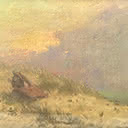When Evening Shadows Fall
22 x 30 cm
PROVENANCE Private Collection, Hawkes Bay Purchased from Webbs', Auckland 29th and 30th June 1999 lot 1216) as The Lonely Shore
LITERATURE Leonard Bell, A Star is Reborn, Art New Zealand 84, p. 77 Roger Blackley, Goldie (Auckland Art Gallery 1997), p. 16
EXHIBITED Wellington, New Zealand Academy of Fine Arts, 1900 as There is rapture on the lonely shore. There is a society where non intrude (Byron), no. 48. Goldie, Auckland City Art Gallery, 1997, cat no. 17 Goldie,Te Papa, 2 April - 18 July 1999
Goldie is one of the best-known and eminent New Zealand artists, both during his lifetime and now. He is most associated with his Maori subject pictures, for which in the twentieth century's first decade he came to be regarded as one of the best, perhaps the best New Zealand artist. Goldie painted other subjects too. Two notables examples are his extraordinary, though little- seen The Christ Child in the Temple (1912, Auckland Art Gallery), on which he worked for about ten years after his return from art school and studies in France in 1898, and When Evening Shadows Fall, also little-seen since first exhibited at the New Zealand Academy of Fine Arts in Wellington in 1900. Its last public exhibition was in the 1999 Te Papa Goldie retrospective.
The painting's initial title, 'There is rapture on the lonely shore/ There is society, where none intrudes (Byron)', signals Goldie's European, in this instance, Anglo- romantic perspective. Where the shore in the painting is located geographically and who the solitary, slightly contorted and obscure figure may be are neither specified nor identifiable. Ambiguity reigns, for which the paintings rather murky atmospherics are apt. In this respect, as well as the connotations of both the first and present titles, Goldie's painting echoes Symbolist currents in fin-de-siècle European painting. For example, the celebrated French artist Eugène Carrière (1849- 1906), many of whose sombre, near monochrome (or monotonal) paintings were characterised by their dreamlike moods, comes to mind. When Evening Shadows Fall shares that amorphousness, even if it is not quite so minimal colouristically. Passages of red low-toned reddish brown, blue-greys and green, for instance, somewhat enliven the gloam. The Evening Post reviewer in 1900 wrote of the painting's 'misty-mystic atmosphere', which was commonly found in Symbolist paintings too. In short, Goldie's picture would not have looked out place in Europe then, though it would have in New Zealand in 1900.
It is also an anomalous work in Goldie's oeuvre overall. This painting exemplifies too the diversity that in fact marks that oeuvre. To see Goldie's paintings only through a Maori subject lens limits how his art can be seen and understood, since on his return to New Zealand he presented himself very much as a western European- oriented cosmopolite. The staged photograph of him at work in his studio published in several papers and periodicals in the early 1900s clearly demonstrates that 'identity'. When Evening Shadows Fall is there, along with other 'stuff', including a Japanese silk hanging, a bust of Dante, the early Renaissance Italian poet, an 'oriental' carpet, plus Goldie's own Christ Child in the Temple, a prime focal point in the photograph. To explore the title further: a hymnal published by a prominent English clergyman, Rev. J. W. Hewett (1859) included What time the evening shadows fall, while a moody landscape painting (1879) in the Russell Cotes Art Gallery in Bournemouth by the English artist, Edward Walton (1860-1922) shares the title too, almost. Walton's shadows 'softly' fall. (The Van Morison song, the first line of which is When evening shadows fall, Goldie, obviously, cannot claim credit for.)
Goldie transformed, though, what could otherwise be a commonplace, even banal sentiment into a peculiar, strangely compelling picture. This painting is small with a much freer handling of paint than his larger paintings. Perhaps Goldie had planned a bigger version of When Evening Shadows Falls, which never eventuated because of the change of direction in the predominant subjects of his exhibited paintings that occurred soon after. His Maori subject paintings proved enormously popular and successful and they became his main concern. Goldie, it seems, had a keen sense of market preferences, though, now, that makes When Evening Shadows Fall a rarity indeed. Leonard Bell





